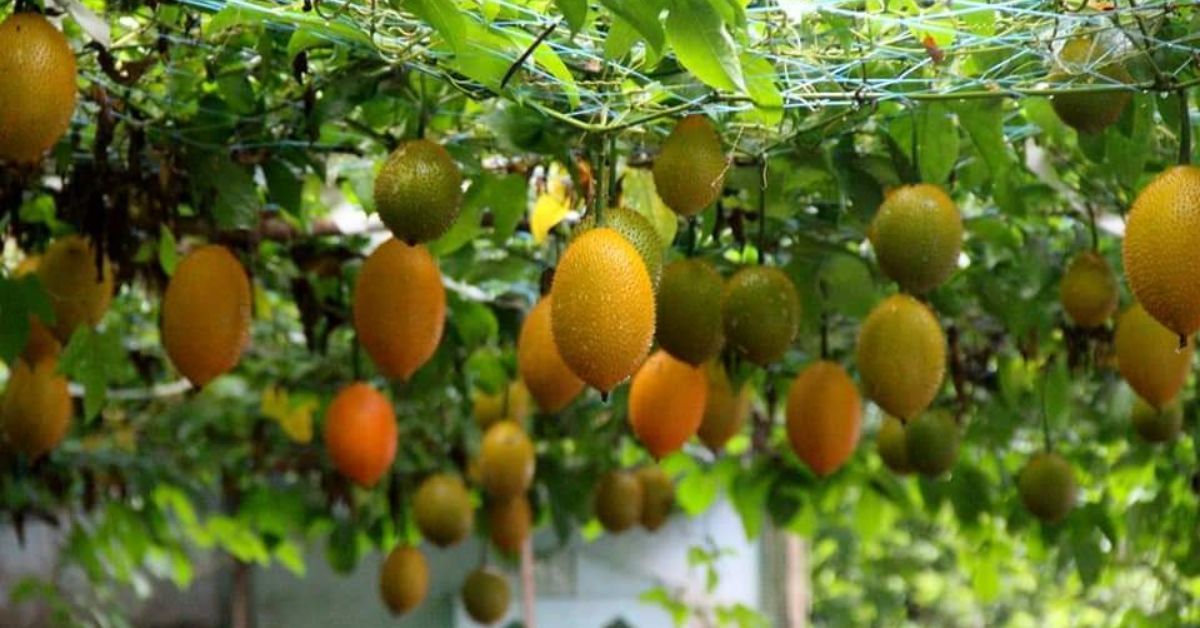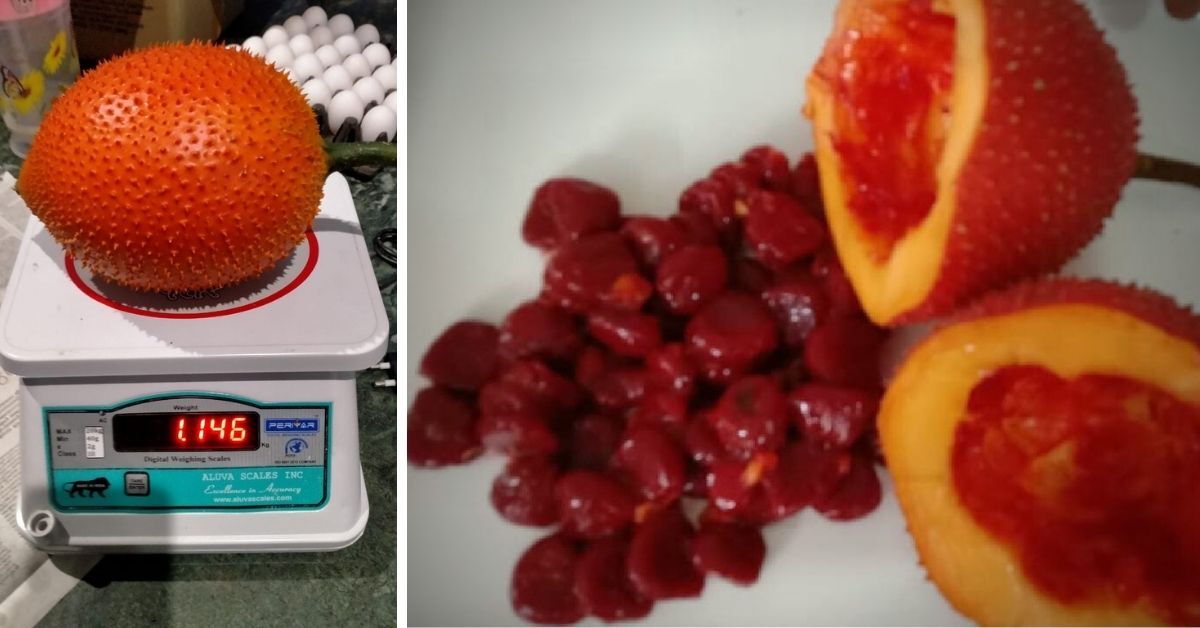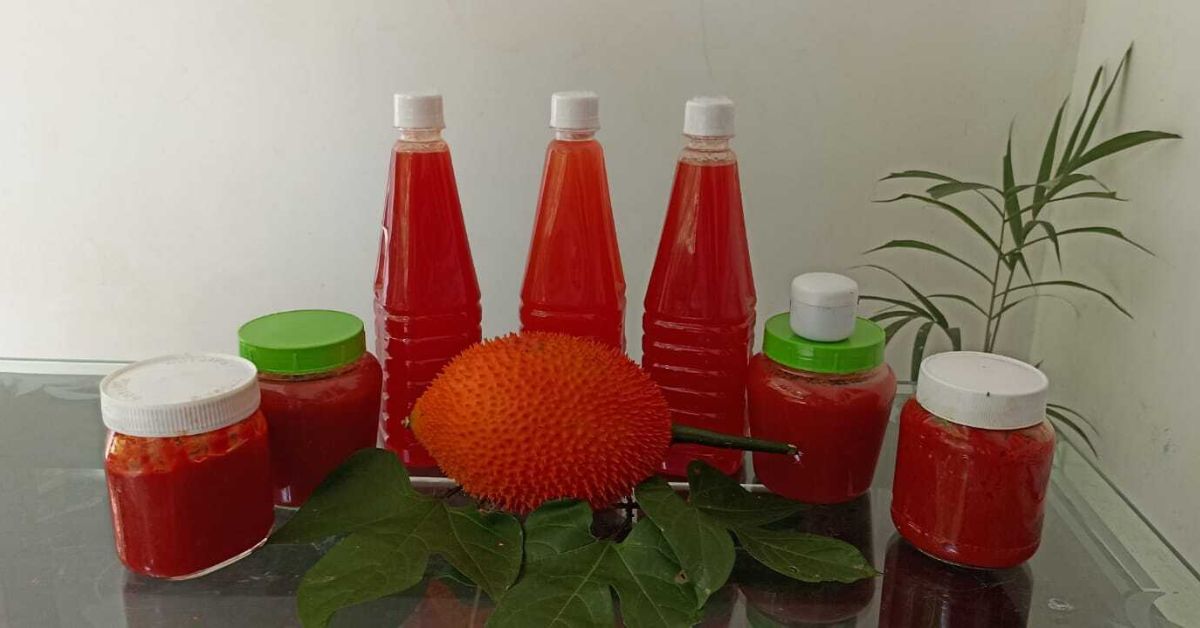Kerala Farmer Grows Rare ‘Fruit of Heaven’, Earns Lakhs From Seeds Alone
Jojo Punnackal from Ernakulam, Kerala has been growing the gac fruit — an exotic and nutritious fruit from Vietnam — for the past four years. He earns around Rs 2 lakh by selling its seeds alone.

A melon-sized fruit in bright reddish-orange colour with a spiny exterior caught Jojo Punnackal’s attention in 2018 while he was conducting an event for a social welfare organisation in Vaikom, Kerala. Though he wasn’t sure about the fruit, curiosity made him collect a few of its seeds from the person who presented it at the event.
It was those few seeds that later changed his life and made him more invested in agriculture.
Now his house at Amalapuram near Angamaly in Kerala is famed for growing an exotic and nutritious foreign fruit known as gac fruit. Scientifically known as Momordica cochinchinensis, this fruit is native to Vietnam and grows well in the warmer climate regions of Southeast Asia.
“Though my family was into agriculture for generations I wasn’t very keen about it until I discovered gac fruit and the scope of growing it. We have a few cash crops like rubber, areca nut, etc. on our land but gac turned out to be my most prized possession,” Jojo tells The Better India.
Today, he grows over 30 gac fruit plants on his house terrace, front yard and also in 60 cents of land around his house. He also sells the seeds of the exotic plant and earns around Rs 2 lakh per year.

Growing the ‘fruit of heaven’
In 2018 when Jojo planted the first seeds of the gac fruit, he recalls that he wasn’t aware of its taste or nutritional qualities. “It was just after the 2018 floods in August that the seeds kept in my house remained under water for one or two days as our area was also hit. After the calamity, I found the seeds and decided to plant them directly as they were soaked in water for a few days. I was very curious as I had no clue about how the plant would turn out,” says the 48-year-old.
Within a few months he realised that it grows exactly like passion fruit — by climbing vines — says Jojo who soon started digging for more information on the plant. “Within three to four months the plant started flowering and that’s when I started studying and researching about gac fruit online. I was surprised to realise that it was widely cultivated in countries like Vietnam, Cambodia, Thailand, Myanmar, Laos, South China and North East Australia,” says Jojo, who also runs a branding company.
“But I was even more amazed to learn about its nutritional quality and the huge market for these fruits and its value-added products in those countries,” he adds.
Jojo says that among the six plants he planted, three of them were female and three were male, which he wasn’t aware of until they bore fruits. “In 2018 December, we got our first fruits and it was quite fascinating to see such vibrant coloured fruits hanging from the vines like bulbs. In its initial stages, the fruit will be in green colour, later it turns to yellow, then orange and then to a reddish-orange colour,” he explains.

The gac fruit, when cut open, has an orange-coloured edible fleshy interior with black-coloured seeds with a dark red pulpy covering. “A single fruit can weigh up to 1 kilogram and a single plant can bear up to 50 fruits in one season,” says Jojo, adding that he gets the yield twice a year now. “These plants start yielding fruits usually from December to March. Soon after the yielding period, it needs to be pruned for better yield next time,” he adds.
Also known as Chinese bitter cucumber or spiny gourd, these fruits are regarded as the ‘fruits of heaven’ due to their nutritional benefits. “Not just the fruit, even the seeds and leaves of this plant have several medicinal properties. It has been used in treating conditions related to skin, and eyes and the fruit is consumed widely for boosting immunity, heart health, good skin and so on. In fact, it is these numerous health benefits and qualities that earned them the name — the fruit of heaven,” Jojo points out.
According to several studies, these fruits are a good source of antioxidants (carotenoids), especially beta-carotene and lycopene. Other carotenoids like lutein, zeaxanthin and beta-cryptoxanthin have also been identified to be present at considerable levels in the fruit.

Research shows that the zeaxanthin content in gac fruit helps in protecting eye tissues from exposure to UV rays and also helps in reducing oxidation of eye tissues. The beta-carotene in Gac fruit helps to maintain good night vision and reduces the risk of blindness. Besides, the high content of beta-carotene makes it a good source of vitamin A which is essential for the immune system.
“Several companies in places like Vietnam have been selling gacs as supplements. They have also been included in face creams, etc due to its anti-ageing properties,” says Jojo, adding that after the first yield he started learning tips and tricks of growing gac fruits on a large scale from the Vietnamese and YouTube channels.
Exploring the potential of Gac fruit
After learning about the potential of the fruit, Jojo says that he gained enough confidence to expand its cultivation. “I didn’t sell the fruits, instead I started preserving the seeds and eventually expanded the cultivation. Last year, in 2021, I set up gac fruit cultivation on around 60 cents of land around my house after replacing all the rubber trees I had planted there. Currently, I have over 30 plants where each plant bears around 40-50 fruits per season,” he elaborates.

“The market price for 1 kg of gac fruit ranges between Rs 900 to Rs 1,200 but I haven’t started selling the fruits commercially. I was mostly focusing on preserving seeds for expanding cultivation and also for selling it,” says Jojo, who has been selling gac fruit seeds for Rs 300 per packet of seeds. “The seed packet contains six seeds as it is difficult to figure out male and female seeds. We can only identify the gender once it flowers.”
He adds, “I have earned around Rs 15,000 per month and an average of Rs 2 lakh per year from the seeds.”
Ramesan from Kannur, who bought seeds from Jojo says, “I visited Jojo and bought the seeds from him last year. Within three months it flowered and it has so far yielded around 200 fruits.”
Jojo says these fruits grow well in places with good sunlight and a slightly dry climate where irrigation is possible. Another important aspect to keep in mind while growing gac fruit trees is that it is essential to growing both male and female plants for pollination. “Though pollination could happen naturally, it is better to pollinate the flowers manually as it can guarantee around 90 per cent successful results. Natural pollination would result in only 40 per cent success. One male plant for five female plants is the perfect ratio,” says Jojo, who claims to only uses organic fertilisers like cow dung powder for the plants.
The fruit isn’t sweet or has any particular taste but can be consumed as a juice by adding other ingredients like sugar or honey. “We usually use the ripe fruit to make juice to which other fruit flavours or juices can be added. It is consumed mainly for its medicinal benefits, therefore, it can be incorporated into food and drinks easily,” says Jojo, who also uses the raw fruit as a vegetable to make thoran and add in curries. “It tastes a bit bitter when tasted raw,” he adds.

The red pulp covering the gac fruit seeds is a good colouring agent and the Vietnamese use the pulp for adding colour to a rice dish that’s usually served during auspicious events like weddings, festivals and so on.
Several other value-added products like skin creams, soaps, jams, oils and so on can be made using the products.
“But people in India are still not aware of the potential of this magical fruit, which is sad. So, I wanted to sell its seeds to those who are interested in cultivating. So far I have distributed seeds to over 3,000 people among which around 300 of them have already started harvesting the fruits,” says Jojo.
For gac fruit seeds, you can contact Jojo at 8606856474.
Sources:
Gac: Strange Name, Powerful Fruit
Efforts to develop commercial cultivation of gac fruit
Edited by Yoshita Rao
If you found our stories insightful, informative, or even just enjoyable, we invite you to consider making a voluntary payment to support the work we do at The Better India. Your contribution helps us continue producing quality content that educates, inspires, and drives positive change. Choose one of the payment options below for your contribution- By paying for the stories you value, you directly contribute to sustaining our efforts focused on making a difference in the world. Together, let’s ensure that impactful stories continue to be told and shared, enriching lives and communities alike. Thank you for your support. Here are some frequently asked questions you might find helpful to know why you are contributing?

This story made me
-
97
-
121
-
89
-
167














